
El Camino Real is a 600-mile (965-kilometer) commemorative route connecting the 21 Spanish missions in California, along with a number of sub-missions, four presidios, and three pueblos. Historically associated with a network of royal roads used by inhabitants of New Spain, the modern commemorative route in the U.S. state of California is named after these roads, with its southern terminus at Mission San Diego de Alcalá and its northern terminus at Mission San Francisco Solano in Sonoma, California.

Ephraim W. Morse was an early settler of the city of San Diego, and was partially responsible for many of its expansions as a city, such as attracting the Atchison, Topeka and Santa Fe Railway and proposing Balboa Park.
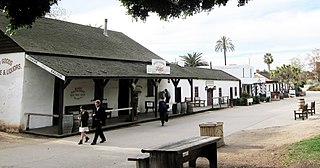
Old Town San Diego State Historic Park is a state protected historical park in the Old Town neighborhood of San Diego, California. The park commemorates the early days of San Diego; it includes many historic buildings from the period 1820 to 1870. The park was established in 1968. In 2005 and 2006, California State Parks listed Old Town San Diego as the most visited state park in California.

A California Historical Landmark (CHL) is a building, structure, site, or place in the U.S. state of California that has been determined to have statewide historical landmark significance.

Jessop's Clock is a large outdoor pendulum clock located in San Diego, California, United States. It was commissioned in 1905 by one of the city's noted jewelers, Joseph Jessop.
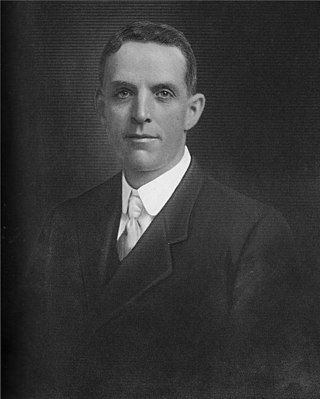
"Colonel" Ed Fletcher was a real estate developer and U.S. Republican and Democratic politician from San Diego, California.

The Casa de Estudillo, also known as the Estudillo House, is a historic adobe house in San Diego, California, United States. It was constructed in 1827 by José María Estudillo and his son José Antonio Estudillo, early settlers of San Diego and members of the prominent Estudillo family of California, and was considered one of the finest houses in Mexican California. It is located in Old Town San Diego State Historic Park, and is designated as both a National and a California Historical Landmark in its own right.

Havilah was an unincorporated community in Kern County, California that was completely leveled by the 2024 Borel Fire. The land is located in the mountains between Walker Basin and the Kern River Valley, 5 miles (8.0 km) south-southwest of Bodfish at an elevation of 3,136 feet (956 m).
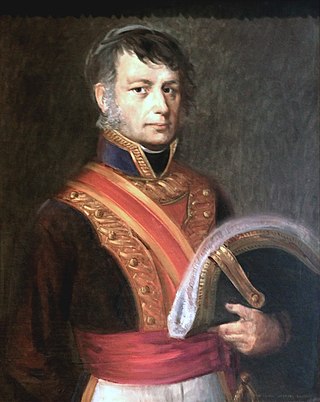
The Estudillo family is a prominent Californio family of Southern California. Members of the family held extensive ranchos and numerous important positions, including California State Treasurer, Mayor of San Diego, and Commandant of the Presidio of San Diego.
Fresno City is a former settlement in Fresno County, California. It was located at the head of navigation on Fresno Slough 2 miles (3.2 km) northwest of Tranquillity, at an elevation of 164 feet. The city was named after the Spanish word for the Oregon Ash trees that commonly grew along the river banks.
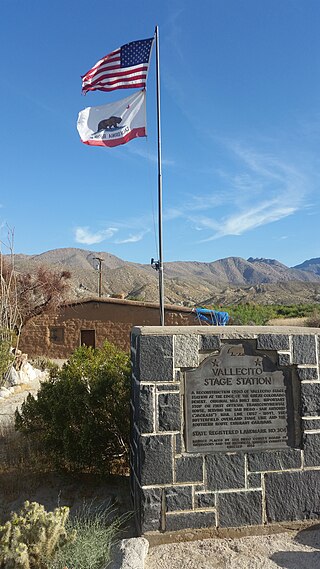
Vallecito, in San Diego County, California, is an oasis of cienegas and salt grass along Vallecito Creek and a former Kumeyaay settlement on the edge of the Colorado Desert in the Vallecito Valley. Its Spanish name is translated as "little valley". Vallecito was located at the apex of the gap in the Carrizo Badlands created by Carrizo Creek and its wash in its lower reach, to which Vallecito Creek is a tributary. The springs of Vallecito, like many in the vicinity, are a product of the faults that run along the base of the Peninsular Ranges to the west.

Mary Chase Walker, Mrs. Morse was an American schoolteacher, pioneer, and suffragette. In 1865 she became the first school teacher at Mason Street Schoolhouse, the first public school to be built in San Diego County, California. She recorded her Recollections of Early Times in San Diego in 1898.

The George Hill Building is an historic structure located at 527 F Street in San Diego's Gaslamp Quarter, in the U.S. state of California. It was built in 1897.

Camp Salvation was a refugee camp set up on September 23, 1849, to help those traveling to the California Gold Rush. Emigrants were crossing the harsh Sonoran Desert to get to California through the Southern Emigrant Trail. The camp was located in the current town of Calexico, California. Lieutenant Cave Johnson Couts, an Escort Commander with the International Boundary Commission set up the camp. From September 23 till December 1, 1849, the camp helped travelers on the trail. In June 1849 the United States Boundary Commission arrived in San Diego to survey the international border between United States and Mexico.

Casa de Carrillo House in San Diego, California, in San Diego County, is a California Historical Landmark No. 74 listed on December 6, 1932. The Casa de Carrillo House is the oldest residence in San Diego. The Casa de Carrillo House was built by Presidio of San Diego Comandante Francisco María Ruiz (1754–1839). Ruiz was the leader of the Presidio from 1809 to 1827. The Casa de Carrillo house was built next to his pear orchard planted in 1808. The adobe house was used by his relative and soldier, Joaquín Carrillo, and his family. Joaquín Carrillo, daughter Josefa Carrillo, ran away and sailed from the home and eloped to Chile with Henry Delano Fitch in April 1829. Francisco Ruiz died in 1839, when Joaquín Carrillo died, his son Ramon Carrillo sold the house and land to Lorenzo Soto. The house and land was sold a few times, it was poor condiction when sold in 1932 to George Marston and associates. George Marston and associates restored the house. After the restoration George Marston and associates donated the house and land to the City of San Diego. The City of San Diego turned the house and land into the Presidio Hills Golf Course.

Casa de López was a historical adobe building in San Diego, California, constructed in the early 1800s. The Casa de López site is a California Historical Landmark No. 60, listed on December 6, 1932. Often called la casa larga, or long house, it was built for the López family, early Spanish settlers of San Diego.
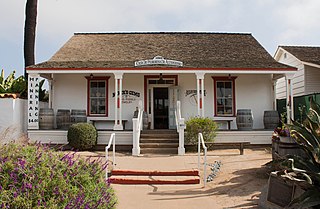
Casa de Pedrorena, also called Altamirano-Pedrorena House is a historical Adobe building in San Diego, California built in 1869. The Casa de Lopez site is a California Historical Landmark No. 70, listed on December 6, 1932. Casa de Pedrorena was the home of Miguel de Pedrorena. In 1838 Miguel de Pedrorena arrived in San Diego Viejo. Don Miguel was a member of the California Constitutional Conventions at Monterey, California in 1849. Monterey Convention of 1849 was the first California Constitutional Convention to take place, a major decidion of the convention was to ban slavery and set state boundaries. Pedrorena sister, Isabel de Altamirano, received the house in January 1871. Isabel de Altamirano married Jose Antonio Altamirano and they raised their family here. Jose Antonio Altamirano was born in 1835 in La Paz, Baja California. Jose Altamirano arrived in San Diego in 1849. In San Diego he did some mining and raised cattle in San Diego and Baja California. The house's current address, 2616 San Diego Ave in Old Town, San Diego. Casa de Pedrorena is the newest and last of Old Town San Diego's adobe houses.

Casa de Stewart, also called La Casa de Machado y Stewart, is a historical adobe building in San Diego, California, built in 1835. The Casa de Stewart site is a California Historical Landmark No. 73, listed on December 6, 1932.

San Diego Viejo Plaza, also called Plaza de Las Armas, Old Town Plaza, and Washington Square, is a historical site in San Diego, California. The San Diego Viejo Plaza site is California Historical Landmark No. 63, listed on December 5, 1932. The plaza was the center of Pueblo de San Diego, founded in 1835 in Alta California.






















